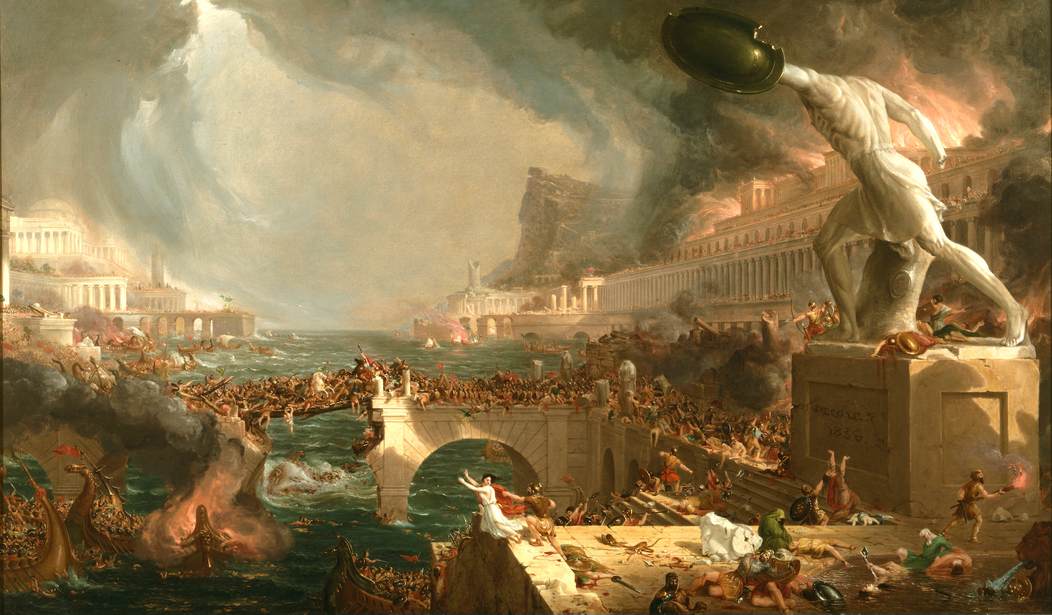See, everywhere, prosperity raging to its ruin.
“Satyricon”
The similarities between the current American decline as a world power and the collapse of the Roman Empire have often been remarked. (After the western part of the Roman Empire fell, the eastern half continued to exist as the Byzantine Empire for hundreds of years. Therefore, the “fall of Rome” really refers only to the fall of the western half of the Empire.) The analogy has become a staple cliché of popular opinion and historical scholarship. The correspondences between Rome and America are compelling and, when the issue is regarded with fresh eyes and attention to taxonomic detail, will strike us with a sense of genuine foreboding.
The factors leading to the fall of the Roman Empire, conventionally dated 476 AD, following the attack of the barbarian chieftain Odoacer, are eerily reminiscent of the nodal “single point failures” observable in 2023 America. Briefly:
The Welfare State
Starting in 123 BC, the powerful reformist Tribune Gaius Gracchus installed a monthly free dole of grain and provided for the entertainment of a decadent citizenry — in poet Juvenal’s phrase from “The Satires” (Satire 10), circa 127 AD: “They shed their sense of responsibility/…and reveal their desire for two things only/bread and circuses.” The practice continued well into the later years of the Empire. The analogy with the American panoply of food stamps, “Great Society” amenities, payment to single mothers, provision of flat-screen TVs and other luxury items, and the contribution of welfare expansion to family breakdown, is stunning.
Debt
Under the Emperor Diocletian, personal debt led to the abandonment of mortgaged property — in our terms, the collapse of the subprime mortgage market. Enormous public debt crippled Rome’s economy. America’s debt, both funded and unfunded, hovers in the unimaginable trillions. As Will and Ariel Durant wrote of Rome in “The Lessons of History,” “Huge bureaucratic machinery was unable to govern the empire effectively with the enormous, out-of-control debt.”
We are seeing the same disaster unfolding before our very eyes. Michael E. Newton warns in “The Path to Tyranny,” “By 2035, the debt is projected to be between 79 and 181 percent of GDP…The United States is clearly on the road to bankruptcy.”
Taxes
Tax rates rose gradually but insupportably upon the Roman “middle class” or equites — farmers, small landholders, merchants, administrators — until economic productivity collapsed. To complicate matters, punitive taxes on the wealthy inevitably led to a flight of capital, in Rome as well as the United States. “The burden will then fall,” Newton writes, “on the middle class, who will also be forced to leave [their holdings] when their tax burden becomes unbearable… This occurred in ancient Rome and could just as easily take place in the United States.” The policy regarding taxes in the early portion of the reign of Tiberius, as Suetonius reports in “The Twelve Caesars,” namely, “it is part of a good shepherd to shear his flocks, not skin them,” soon came to be disregarded.
Agriculture
Regulations around food production are among the most critical issues. Arther Ferrill writes in “The Fall of the Roman Empire” that “the chief cause of the agricultural decline was high taxation on marginal land, driving it out of cultivation.” In today’s America, high taxes along with political decisions resulting in spiraling inflation and a depreciating currency are having the same effect. In countries like Holland and Canada, carbon and nitrogen taxes are having an increasingly damaging impact. In the U.S., fuel excise taxes are an implicit form of carbon pricing, covering 28.4% of emissions in 2021, with no letup in sight. Along with the reduction in chemical fertilizers, “green” pricing protocols and government mandates will further decimate the food supply. As the popular saying goes, No farmers, No food. Cricket mash is no substitute.
Outsourcing
Supplementing the tax debacle, Rome’s economy stagnated from a large trade deficit, especially as grain production was outsourced to Egypt. In “Barbarian Europe,” Gerald Simons traces the effects of this imbalance. “As conquerors in North Africa, the Vandals cut off the Empire’s grain supply at will. This created critical food shortages.” America’s curtailing of its energy industry and reliance on the importation of foreign oil is vulnerable to similar threats and pressures, high costs, and potential scarcity of a crucial resource.
Open borders
Rome was overwhelmed by a flood of illegal immigrants: Visigoths, Ostrogoths, Franks, Anglos, Saxons, Alemanni, Thuringians, Jutes, Picts, Burgundians, Alans, Vandals, and Lombards. It did nothing, as the Durants wrote in their magisterial “The Story of Civilization” (Vol. 3), “to let assimilation catch up with infiltration” — although in the American context under a Democrat president and Senate, assimilation was never the goal. Millions of new and grateful Democrat voters were. Changing the demographic profile of the nation is the plan.
No empire or country can survive indefinitely under such conditions. James O’Donnell points out in “The Ruin of the Roman Empire” that the barbarian invasions were not the decisive factor in the fall of Rome. This is a common misconception. Rather, “It all started with a refugee crisis.” This was the real invasion that unraveled “the necessary thread of Roman rule.”
Tyranny
After Julius Caesar’s crossing of the Rubicon in 49 B.C., the Roman Republic began to dissolve. 27 B.C. is the date assigned to the beginning of the Roman Empire, the subsequent principle of dynastic succession, and ultimately the rule of tyrants, many of whom were profoundly corrupt and some demonstrably unhinged. Nero and Caligula are the usual villains in the popular mind, but one also thinks of emperors like the devious and narcissistic Elagabalus, whom Stephen Welton Taber compares to Obama, and the devastating reign of the demented Commodus, who renamed Rome Colonia Lucia Annia Commodiana. As historian Greg Daugherty writes, “Sanity was never Commodus’ strong suit, and he seems to have become ever more divorced from reality as his rule went on.” The investiture of Commodus to the emperorship of Rome is conventionally seen to mark the beginning of the end. In the view of the Greek-Roman historian Cassius Dio, his accession in A.D. 180 marked the descent of Rome “from a kingdom of gold to one of rust and iron.”
The United States today languishes under the authoritarian rule of a cognitively challenged president, a vice-president no one takes seriously, a Democrat Party gone off the rails, a Commodian Senate, the political subversion of the national media, and the weaponization of virtually all state agencies. It has become obvious that the Potomac has also been crossed, an unstable Commander is in power, a despotic government has turned against its own citizens, and the nation has precipitously declined from gold to rust and iron. “No tyranny is more cruel,” writes the great political philosopher Baron de Montesquieu, “than the one practiced in the shadow of the laws and under color of justice.”
Related: Is America Still Worth Celebrating?
As noted at the beginning of this article, innumerable books have been written on the fall of Rome and, more recently, several dealing with the prophetic relation of Rome to present-day America. But the mirror that reflects the current state of affairs most disturbingly was crafted and polished two millennia ago, at the time of Nero’s immiserating reign. Petronius’ “Satyricon” furnishes a detailed panorama of Roman society, its baroque excesses, moral decadence, and the widening chasm between the vast wealth of a few and the growing drudgery of the many.
Replete with scenes of vagabondage, sexual depravity, political irresponsibility, an underworld of professional hustlers, and a manumitted asylum of ostentatious nouveau riche, the book is an entertaining pastiche of the social carousel of the time, composed in the genre known as Menippean satire. But it also has its grim side, serving as a kind of proleptic and vernacular transcript of what we observe happening on the national stage today. Absent the picaresque humor and making allowance for the specific, determining features of the era, the “Satyricon” is as contemporary as it gets, foreshadowing the travails, compulsions, and absurdities of the American moment. It’s a book that hits home.
Can America survive its own Satyricon? Cullen Murphy’s excellent “Are We Rome?: The Fall of an Empire and the Fate of America” argues that the parallels between America and Rome are uncannily salient, and that unless we can somehow initiate a course correction, Rome’s destiny may well be ours.
Murphy believes, however, that revival is possible because “America is very consciously a constant work in progress,” politically, technologically, and economically mobile as Rome, agrarian and preindustrial, was not. “America has lived through more social transformation in a few centuries,” he writes, “than Rome did in a millennium.” This is intended as a positive assessment. One might also say that America has lived through more change and upheaval in two or three electoral cycles than Rome did in centuries, not necessarily for the better. Murphy’s book was published in 2007, before Obama, Biden, and the national crime syndicate known as the Democrat Party clamped its dead hand upon the nation.
Is the historical concordance between Rome and America set in stone? Are we on the brink of losing our home? The question, like the Overton Window, remains only partially open.
Author’s note: I owe a debt of gratitude to my colleague Hildegard Horie for her encouragement and suggestions in regard to the writing of the first part of this article.
“The Decline and Fall of Home: Part Two” will be published on PJ Media on Sunday, Oct. 1.










Join the conversation as a VIP Member